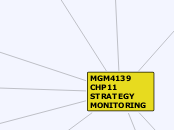MGM4139 CHP11 STRATEGY MONITORING
The Nature of Strategy Evaluation
Strategy Evaluation
Vital to the organization’s well-being
Alert management to potential/actual problems in a timely fashion
Erroneous strategic decisions can have severe negative impact on organizations
Complex & sensitive undertaking
Overemphasis can be costly & counterproductive
3 Basic Activities
Examine the underlying bases of a firm’s strategy
Compare expected to actual results
Corrective actions
Appraisal of Strategic Performance
Have assets increased
Increase in profitability
Increase in sales
Increase in productivity
Profit margins, ROI, & EPS ratios increased
Rumelt 4 Criteria
Consistency
Feasibility
Advantage
Consonance
Difficulties
Increase in environment’s complexity
Difficulty predicting future with accuracy
Increasing number of variables
Rate of obsolescence of plans
Domestic and global events
Decreasing time span for planning certainty
Strategy Evaluation Framework
Taking Corrective Action
Alter the firm's structure
Replace one or more key individuals
Divest a division
Alter the firm's vision or mission
Revise Objectives
Alter policies
Devise new policies
Install new performance incentives
Raise capital with stock or debt
Add or terminate salespersons, employees or managers
Allocate resources differently
Outsource (or rein in) business functions
Measuring Organizational Performance
Activities
Comparing expected results to actual results
Investigating deviations from plans
Evaluating individual performance
Examining progress
Strategy evaluation based on
Quantitative criteria
Qualitative criteria
Reviewing Bases of Strategy
Develop a revised IFE and EFE Matrices
-to prevent any upcoming failures toward the organization's objectives
S-W-O-T of the current strategies shoud be continually monitored for a better change
The Balanced Scorecard
allows firms to evaluate strategies
from 4 prospectives
financial performance
internal business processes
customer knowledge
Learning and growth
6 Key issues
customers
managers/employees
operations processes
community/social responsibility
business ethics/natural environment
financial
aims to balance:
Long terms & short terms
Financial & Nonfinancial
Internal & External
Published Sources of Strategy-Evaluation Information
Fortune
People management
Use of assets
Long-term investment
Social responsibilty
Global competitiveness
Financial soundness
Quality of management
Product quality
Innovativeness
Businessweek
Industry Week
Dun's Business Month
Characteristics of an Effective Evaluation System
Economical
Adequate info
Adequate control
Meaningful to managers
Provide timely info
Simple
Provide current situation
Do not dominate decision
Contingency Planning
Alternative plans that can take into action if certain strategy/plan do not occur as expected
The organization need a major change after the evaluation phase - thus, can promote a strategist's ability to respond quickly
Benefits of Contingency Planning
It permit quick response to change
It prevent panic in crisis situations
It made managers more adaptable the changes
Five-step process of effective Contingency Planning
Identify events that could jeopardize strategies
Determine when the events occur
Determine the expected pros and cons of each contingency events
Develop contingency plans for key contingency events
Determine early warning trigger points key contingency events
Auditing
A systematic process of objectively obtaining and evaluating evidence - assert and communicate the results to interested users
Old standard - Generally Accepted Accounting Principles (GAAP)
New standard - International Financial Reporting Standards (IFRS)
Reason of switching standards from GAAP to IFRS
IFRS rules are more streamlined and less complex than GAAP
21st-Century Challenges in Strategic Management
The Process of Evaluating Strategies
Should
Initiate managerial questions of EXPECTATION & ASSUMPTIONS.
Trigger a review of OBJECTIVES & VALUES
Stimulate creativity in generating ALTERNATIVES & CRITERIA of EVALUATION
Performed in CONTINUING BASIS
NOT in the end of specific time or when problems occurred.
Managers and employees shold be aware of the firm's progress
Example : If the assumptions made are deviate significantly from forecast, then a change or renew in Strategy-Formulation is needed.
Organizational members should involved.
Top-Down or Bottom-Up
'Bottom-Up'
Manager + employee involve in decision making
'Top-Dowm'
Top executive makes decision
Art or Science
More as Science
Pros + cons alternative
Perform analysis
Decide action
Access Internal + External environment
Research
Mintzberg's notion : More as Arts
Emotion
Hunch
Creativity
Politics
Visible or Hidden
Business Organisation prefer Visible
Advantages
All staff involve
Full support
Democracy
Enhance commitment,understanding + communication
Reason
Secret inhibit communication
Inhibit understanding
Inhibit commitment
Cant implement strategy well
Sun Tzu: Strategies is secret
Advantages
Free disemination
Limit critisicm
Less attractive to rival
Strategy cant be duplicated
War based on deception
